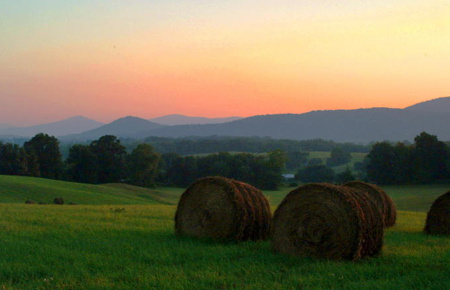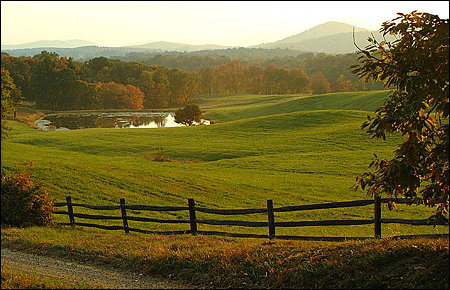This article was written for the Culpeper Soil and Water Conservation District’s Spring 2013 newsletter.

Virginia’s Piedmont is a unique place with exceptional natural resources, productive farms and forests, and a landscape steeped in history. The farms and forests in Culpeper Soil and Water Conservation District’s five-county region are vital to the financial well-being of the regional and state economy, and each year hundreds of thousands of tourists come to experience our natural wonders and historic heritage.
Yet, this area also happens to be located near some of the most rapidly growing areas in the country. Residential sprawl has radiated outward from Washington, D.C. and other urban centers in Virginia at a tremendous rate — leading to subdivision and suburbanization of once viable farmland, forests, and historic battlefields. One way to ensure that your property or working farm will endure for future generations is by permanently protecting it with a conservation easement.
Conservation Easements — The basics
A conservation easement is a voluntary land preservation agreement between a landowner and a land conservation organization. It places permanent limits on the future development of the property in order to protect conservation values of the land. These conservation values could include prime agricultural soils, streams and forests, scenic open space, and historic and cultural features of the property.
Each easement is unique, and the easement terms are negotiated between the landowner and the land conservation organization. When landowners donate an easement, they continue to maintain ownership and management of their land. Therefore, land protected with an easement is still eligible for most cost-share programs administered by Culpeper Soil and Water Conservation District (SWCD) — as they work in concert with easements to further conservation goals. Landowners can still farm the land, hunt, fish, sell the property, or pass it onto their heirs – all the while ensuring that the property will be protected for the benefit of future generations.
In the Culpeper SWCD jurisdiction – Culpeper, Rappahannock, Orange, Greene, and Madison counties — over 101,095 acres are permanently protected with a conservation easement. Along with conserved acreage, there are significant natural and historic features that are now protected in perpetuity: approximately 440 miles of streams and rivers; over 40,038 acres of prime farming soils; 41,164 acres of forests; 19,643 acres along Scenic Byways; and more than 7,760 acres of historic battlefields. These resources not only make the area a great place to live, but they are fundamental to the local and state economies.
The Tax Incentives
While people donate easements because of their love of their land and a desire to see it protected forever, there are also significant tax incentives associated with a donation. For many easement donors, this translates into substantial savings on their federal, state, estate, and local property tax bills. At the end of 2012, Congress temporarily renewed a significant tax incentive for private landowners who voluntarily protect their land, and as a result, landowners have until the end of 2013 to take advantage of temporarily expanded federal income tax deductions for permanently protecting their land.
Through the end of 2013:
- Easement donors can deduct the value of their donated conservation easement at the rate of 50% of their adjusted gross income per year (after this year, the deduction may be limited to only 30% of income)
- Farmers and ranchers can use the deduction at the rate of 100% of their income
- Landowners can use the deduction in the first year and carry over any excess for an additional 15 years (after this year, the carry-forward may be limited to only 5 years).
Virginia also has the best state income tax incentive in the nation for landowners who chose to preserve their land with a conservation easement. Specifically, conservation easement donors in Virginia are eligible for a Virginia Land Preservation Tax Credit – which is equal to 40% of the value of their donation – that can be used to offset their state income tax. For example, if a landowner’s easement is valued at $500,000, the credit is $200,000 ($500,000 x .40 = $200,000). Any portion of the credit that is not used up in the year the easement is donated can be carried over for an additional 10 years.
In addition to being able to use this tax credit to pay their own Virginia income taxes, conservation easement donors can sell the credits to other Virginia income tax payers for cash. The ability to sell these credits is particularly important to “land rich, cash poor” landowners who may not have enough income to offset their own taxes. At the end of 2012, the demand and market price for these tax credits were stronger than ever.
The expanded federal incentive, coupled with Virginia’s Land Preservation Tax Credit program, has contributed to the protection of hundreds of thousands of acres of productive farmland, scenic open space, important forest resources, and significant natural areas throughout the Commonwealth. In the nine-county region where PEC works, from Loudoun to Albemarle, there are now more than 357,000 acres protected by conservation easements.
Conservation Easements Near You
Many of your neighbors and fellow farmers have made the decision to permanently protect their property with a conservation easement.
The Beier family donated an easement on 90-acres to The Piedmont Environmental Council (PEC), permanently conserving their Madison County property along the Robinson River in Weakley Hollow creating a gateway to Shenandoah National Park. In Culpeper, Mountain Valley Farm, a 241-acre historic farm within Brandy Station Battlefield study area, and Triple S Land Management Tract — a 964-acre family-owned farm lying entirely within Kelly’s Ford, Brandy Station, and Rappahannock Station II Battlefields — were placed in easement in 2012. The protection of these two properties with the Virginia Department of Historic Resources not only conserved important cultural and historic features, but they also contribute to enhancing water quality in the Rappahannock River — which provides drinking water to the City of Fredericksburg and other downstream communities. In Orange, Collins Farm, a 600-acre working forest that has been sustainably harvested for generations, was protected this past year. In Greene County, Agnes Fotta donated an easement on 160-acres of scenic farmland, adding to a growing conservation corridor along Sylvia Ridge Road. A smaller yet significant 17-acre parcel was acquired from the Finch family in Rappahannock County, adjacent to Shenandoah National Park Wilderness Area, by PEC with plans to transfer the property to the National Park Service later this year. This acquisition provides additional buffer to the Wilderness Area which will help NPS staff better manage the area and prevent bear poaching.
Threlkeld Farm’s Conservation Story

Another notable farm permanently conserved with an easement is Threlkeld Farm in Culpeper County’s Brandy Station. A couple years ago, Terry Ingram and his mother and brother, Boo Ingram and Rush Ingram, donated a 250-acre conservation easement on their family farm. A year later, Terry’s father David Ingram and aunt, Evelyn Sawyer, donated an easement on the 150-acre Hazel River Farm down the road. Along with his farm and his dad’s farm, Terry manages land that he rents from neighbors, cultivating around a thousand acres altogether. The farms produce corn, sorghum, hay and steers, but the main product is organic milk.
“One of the important things was to save some farmland,” Terry says of his family’s decision to conserve their family farms, “because you see so much of it developed, and it’s obviously never going back to farming.”
The Ingram family used some of the income from Virginia Land Conservation Tax Credits to pay off the debt on their land. The money also provides retirement for Terry’s parents’ generation – including his mother, Boo Ingram, who was a major advocate for protecting Threlkeld Farm and the legacy of her own hard work. “It’s given her a much deserved reward for hanging in there with this farm,” Terry explains.
Beyond the money, Terry finds that placing the land in conservation easement was useful because it solidified his family’s commitment to the farms – giving him the confidence to make investments like a new dairy barn. “I unifies everybody’s thoughts on how to manage the property,” he says. “Whether it stays in the family or not, it’s always going to be a farm.”
Thinking About Donating a Conservation Easement?
In Virginia, easements can be donated to a number of public and private entities. The Piedmont Environmental Council (PEC) is an accredited organization that holds conservation easements on approximately 6,600 acres of land in the Piedmont and is ready to help landowners complete their easement with the best organization for their land. The majority of conservation easements in Virginia are held by the Virginia Outdoors Foundation, which is a State agency. In some cases, the Virginia Department of Historic Resources or the Virginia Department of Forestry may be the best entity to accept your easement. PEC staff will work with you closely to evaluate your options and help you choose the right easement holder for you and your land.
The first step to donating an easement or to find out more information about the process is to contact PEC. Our knowledgeable conservation staff can guide you through the easement donation process and provide you with up-to-date information on tax incentives. We are happy to meet with you and your family to discuss your land conservation options. You should also contact a lawyer and financial advisor to understand how an easement could help you with tax savings and estate planning.
For further information about conservation easements, please contact Maggi MacQuilliam, Land Conservation Officer with The Piedmont Environmental Council, at 540-454-9599 or e-mail mmacquilliam@pecva.org.
